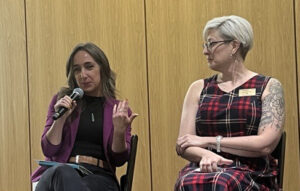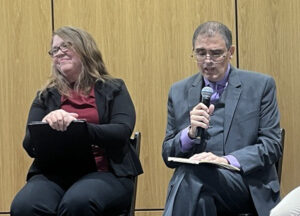The academic-focused event of President Kathryn McClymond’s inauguration featured a panel discussion in Lupton Auditorium on Sept. 19 titled “The Future of the Liberal Arts,” which explored K���� University’s unique approach.
Moderated by new provost and vice president of Academic Affairs, Dr. Gabriel Barreneche, the panel included Dr. Judie Levy representing the Core curriculum; Dr. Katharine Zakos, visual arts, communications and film; Dr. Amanda Whooley, philosophy; Dr. Cassandra Copeland, economics and business; Dr. John Nardo, science, technology, engineering and math; and Dr. Janelle Pham, sociology.
In his opening remarks, Barreneche offered three images: Batman, The letter T and Benjamin Franklin.
“We in higher education have a conceptually impossible task: prepare our students, the future leadership class of society, for the unknown world that they will lead,” Barreneche said. “How do you train students for the unknown if you do not know what lies ahead? We need the timeless future-proof skills of a liberal arts education.”

Barreneche referenced Batman because of his famous utility belt with all the tools he needed to fight crime at his fingertips. He said the liberal arts provide a broad knowledge of the world, past and present – through study of history, philosophy, natural and social sciences, languages, rhetoric, the arts, math and literature. He said the liberal arts toolbelt also has a host of 21st��century skills, including critical thinking, effective communication, written and verbal information literacy, intercultural competency, creative problem solving, and the ability to lead and persuade others.
“Like Batman, we don’t know what villains lurk around the corner,” Barreneche said. “We need an array of intellectual tools and skills on our Batman toolbelt to confront the challenges of the 21st��century.”
The letter “T” was a reference to the vertical and horizontal axis of knowledge and skills encompassed by the liberal arts. Michigan State University researcher, Phil Gardner, described a need in higher education for the “T Academy,” which produces T-shaped employees in the workforce who are successful and flourishing.
The vertical axis in the “T” is deep knowledge and technical skills. The horizontal axis is broad knowledge and skills across several disciplines.
“By their nature, liberal arts institutions produce the T-shaped leaders of tomorrow that we need,” Barreneche said.
Last, he described Franklin as the ultimate T-shaped scholar utilizing a robust set of tools on his Batman utility belt. Franklin had a variety of interests and a broad base of knowledge. He was a scientist, inventor, diplomat, newspaperman and political philosopher.
He was a founder of the University of Pennsylvania and rejected the narrow, technical model of higher education espoused by European universities, in favor of a classical, liberal arts education. Barreneche said Thomas Jefferson did the same when founding the University of Virginia.
“Both Franklin and Jefferson believed that higher education needed to equip an educated voting populace for the responsibilities of democracy,” Barreneche said. “In other words, if our American democracy was going to work, it needed broadly educated populace that understood the world and would place a check on government and tyranny if needed – a liberating education for free people.”

Each of the panelists provided brief remarks on how their disciplines were represented by and made use of the liberal arts. For Levy, the Core curriculum at K���� was interdisciplinary by design and began with an investigation of the self. Representing the arts, Zakos said K���� provided a base of understanding by looking at history and foundations and not just building technical proficiency or skill at techniques.
Whooley made the connection of philosophy to the liberal arts through humility. She said K���� encourages students to understand the value of their own perspectives and appreciate the perspectives of others. In economics and business, Copeland stressed the role the liberal arts play in problem solving and analysis. K���� helps student develop into “the human capital” needed to run our society.
For Nardo, STEM at K���� is at the intersection of the liberal arts and inclusivity.
Pham concluded the disciplinary remarks by passionately arguing that sociology is “the humble servant of the liberal arts.”
“When students ask, ‘What can I do with sociology?’ I tell them, ‘Literally anything!” Pham said. Sociology gives K���� students the tools to make decisions about pursuing their passions throughout their lives, not just in their young adult years while they are undergrads.
The panel discussion wrapped up with questions posed by Barreneche and even members of the audience. Conclusions drawn from the discussion were an affirmation of K����’s identity and commitment as a liberal arts institution.
“Civil society needs liberal education, democracy needs liberal education,” Barreneche said. “Our responsibility at K���� is to prepare students and graduates for much more than the first job out of school. We need to prepare them for lives beyond 9 to 5 – make a life. We need to prepare them for careers in the unknown – make a living. We need to prepare them for membership in and leadership of our civil society – make a difference. And this is why a liberal arts education matters now more than ever.”







